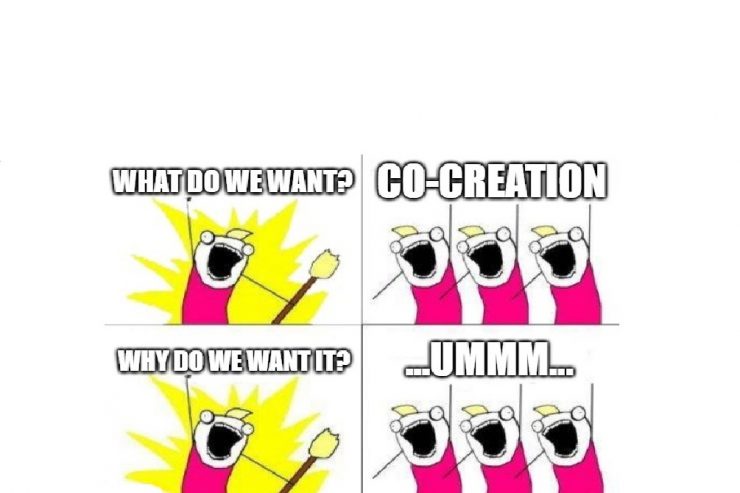In a previous post I presented the Binding Voice of Customer (BiVoc) co-creation canvas, and then the Prerequisites a company ideally needs to get started. Once these prerequisites are ticked off, the company needs to ask itself 4 strategic questions.
1, Is this really what the organization wants? Why now?
Just because an organization can implement BiVoC does not mean it must. Experience shows that once this form of participation is granted, it could become extremely difficult to curb or remove it without considerable backlash. The answer to this questions should also clearly state what triggered interest in a BiVoC approach? Is it belief of management? Is it a customer need? Is it a business need?
Proposed approach: The bases for answering this should be the “why now”. Starting from there, senior leadership should gather initial input during answering ‘Prerequisite’ questions (see previous post). Then, a company-wide co-creation session should gather wider employee feedback. E.g. IBM has run many such wider employee feedback sessions, and now the company uses it as a “proven management tool”.
2, Use both ‘Initiatives’ and ‘Challenges’, or only one of these? BiVoC’s ‘Initiatives’ give users the ability to kickstart a new proposal, whereas ‘Challenges’ give them the ability to challenge company decisions. Initiatives are an input channel, and can be controlled through various mechanisms (see later). But ‘Challenges’ are a much deeper relationship between company and customers. They require a company to be transparent regarding its activities. This transparency may be too much of a barrier for some companies.
Proposed approach: Companies should start with a limited ‘Initiatives’ approach, to understand level of customer activity. From here expansion of ‘Initiatives’ and introduction of ‘Challenges’ can be explored in an iterative manner.
3, What restrictions should be applied, if any? There are three types of restrictions. Restrictions based on intention, restrictions based on circumstances, and restrictions based on domain area.
- Limiting intentions is easier said than done. Intention of customers’ input should aim improvement of service, be in-line with company strategy, but restrict pranks and sabotage. Anything else should be disqualified.
- Circumstances refer to situations outside of company’s direct control, such as a financial crisis, natural disaster etc. In these cases co-creation can be temporarily suspended, to allow for drastic measures that might need to be taken.
- Domain area means the specific are in which the company is open to customer input. In Swiss Direct Democracy, there are hardly any limits. But a company’s co-creation may initially be restricted to only content (in case of a media company), or only one feature set (in case of a digital service), or only products sold (in case of a retailer). It pays off to start with a limited scope. Continuous expansion of the scope is easier than reducing it after launch.
Proposed approach: Restrict intention to ‘improvement of service’, and restrict pranks and sabotage. Define extraordinary circumstances where BiVoC is restricted, such as sudden significant drop in sales, financial crisis, natural disaster, etc. For defining domain areas, start by identifying all activities of the business. Create an ultimate vision of how far the company is willing to go with BiVoC. Then identify a specific domain that is high impact for customers, but relatively low risk for the business.
4, Who can participate? The two important decisions here are:
- who to include
- should votes be weighted?
Distinction for both questions can be made between free and paying customers (e.g. for freemium-type services); based on level of activity (e.g. occasional users vs heavy users); time with the organization; level of involvement with company (e.g. a bank client with large deposits), etc. Considerations will change from company to company.
Proposed approach: some restriction should be applied, ideally based on a combination of time with the organization and level of activity. The restriction itself ensures that participation is seen as a measure of maturity in the relationship between customer and the company. If voting right is not automatically granted, people will appreciate it more once they unlock it. It also offers an opportunity for activity in the branding and experience layer.
These strategic questions can and should be regularly revisited, as the organization develops and expands its ‘Binding Voice of Customer’ approach. In the next post we will dive into the first type of co-creation: the Initiatives.




















